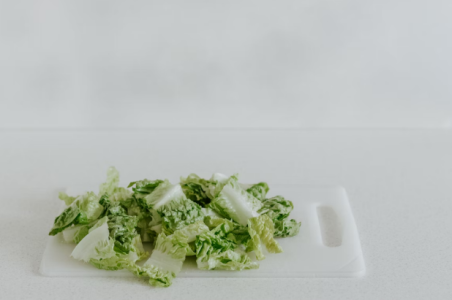“A great way to reuse and regrow”: Lettuce trick goes viral for saving money
- Replies 0
Most people tend to view certain bits and pieces left behind during everyday meal preparation as nothing more than waste, never pausing to consider that they might hold far more potential than their appearance suggests.
What so often finds its way into the trash or compost bin could, with the right approach, actually serve as the humble beginning of something new, fresh, and surprisingly edible.
With just a handful of simple actions and a measure of patience, those overlooked remnants can be transformed into a modest yet rewarding harvest that feels all the more satisfying because it came from what would have been discarded.
One home gardener’s widely shared online video has now captured the imagination of countless viewers, inspiring them to give the idea a try for themselves and discovering results that many have found unexpectedly impressive.
After preparing a salad, most of us sweep the base of the romaine into the bin without a second thought.
TikTok creator Lawren Bagley (@lawrenbagley) showed her 1.5 million viewers why that small leftover should be saved instead.
“Friendly reminder that when you cut off the bottom of a romaine head and plant it, they turn into this,” she said, pointing to a planter filled with new lettuce leaves grown entirely from discarded bases.
She described it as “a great way to reduce, reuse, and recycle,” and her audience responded with interest, curiosity, and plenty of their own growing tips.
The method is straightforward for those who want to try the potting approach. Leave at least one inch of the lettuce base intact when you cut the leaves.
Place it upright in moist potting soil with the cut side facing up, then set it in a sunny location such as a kitchen windowsill.
Source: lawrenbagley / TikTok
Keep the soil damp but not waterlogged, and in time, new leaves will begin to appear from the center.
Not everyone finds success with this technique, as some report tall, thin stems with small leaves or a bitter taste if left to grow too long.
Also read: 16 surprising yard sale finds that could be worth a fortune
For these cases, the alternative water method can be more reliable. The process involves setting the trimmed base in a shallow dish with about half an inch of water and placing it in a sunny spot.
Change the water every day or two, and within 10 to 12 days you should have enough fresh leaves for a sandwich or garnish.
Even though the water method will not produce a full head of lettuce, it can still be a quick way to add fresh greens to a meal.
It requires no soil and minimal space, making it ideal for small kitchens or those without access to outdoor planting.
Also read: 7 budget-friendly places to cool off this summer
The key is harvesting early to avoid bitterness, which can develop if the plant is left too long. Both approaches offer a practical way to extend the life of produce you have already paid for.
Bagley’s viewers also pointed out that the same idea works for other vegetables. Green onions can be regrown by placing the white root ends in water, celery bases can sprout fresh stalks, and even carrot tops will produce edible greens.
Herbs like basil and mint can also root from cut stems placed in water, eventually thriving in pots for ongoing use.
Once you know the process, you may find yourself looking at your vegetable scraps in a whole new way.
Read next: Don’t throw out your chocolate boxes—gardeners are loving this surprising trick!

Have you ever tried regrowing lettuce or other vegetables from kitchen scraps? Did you prefer the soil method or the windowsill water approach? Share your successes, challenges, and tips in the comments to help others get started. You might inspire someone else to turn waste into a small harvest at home.
What so often finds its way into the trash or compost bin could, with the right approach, actually serve as the humble beginning of something new, fresh, and surprisingly edible.
With just a handful of simple actions and a measure of patience, those overlooked remnants can be transformed into a modest yet rewarding harvest that feels all the more satisfying because it came from what would have been discarded.
One home gardener’s widely shared online video has now captured the imagination of countless viewers, inspiring them to give the idea a try for themselves and discovering results that many have found unexpectedly impressive.
After preparing a salad, most of us sweep the base of the romaine into the bin without a second thought.
TikTok creator Lawren Bagley (@lawrenbagley) showed her 1.5 million viewers why that small leftover should be saved instead.
“Friendly reminder that when you cut off the bottom of a romaine head and plant it, they turn into this,” she said, pointing to a planter filled with new lettuce leaves grown entirely from discarded bases.
She described it as “a great way to reduce, reuse, and recycle,” and her audience responded with interest, curiosity, and plenty of their own growing tips.
The method is straightforward for those who want to try the potting approach. Leave at least one inch of the lettuce base intact when you cut the leaves.
Place it upright in moist potting soil with the cut side facing up, then set it in a sunny location such as a kitchen windowsill.
Source: lawrenbagley / TikTok
Keep the soil damp but not waterlogged, and in time, new leaves will begin to appear from the center.
Not everyone finds success with this technique, as some report tall, thin stems with small leaves or a bitter taste if left to grow too long.
Also read: 16 surprising yard sale finds that could be worth a fortune
For these cases, the alternative water method can be more reliable. The process involves setting the trimmed base in a shallow dish with about half an inch of water and placing it in a sunny spot.
Change the water every day or two, and within 10 to 12 days you should have enough fresh leaves for a sandwich or garnish.
Even though the water method will not produce a full head of lettuce, it can still be a quick way to add fresh greens to a meal.
It requires no soil and minimal space, making it ideal for small kitchens or those without access to outdoor planting.
Also read: 7 budget-friendly places to cool off this summer
The key is harvesting early to avoid bitterness, which can develop if the plant is left too long. Both approaches offer a practical way to extend the life of produce you have already paid for.
Bagley’s viewers also pointed out that the same idea works for other vegetables. Green onions can be regrown by placing the white root ends in water, celery bases can sprout fresh stalks, and even carrot tops will produce edible greens.
Herbs like basil and mint can also root from cut stems placed in water, eventually thriving in pots for ongoing use.
Once you know the process, you may find yourself looking at your vegetable scraps in a whole new way.
Read next: Don’t throw out your chocolate boxes—gardeners are loving this surprising trick!
Key Takeaways
- Romaine lettuce bases can regrow leaves when planted in soil or placed in water.
- The potting method may yield more growth but can produce bitter leaves if overgrown.
- The water method is faster and space-efficient but produces a smaller harvest.
- Other vegetables like green onions, celery, and certain herbs can also regrow from scraps.







